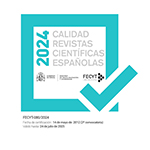Representación gráfica imposible, la Agricultura Familiar en las áreas de secano de Río Negro, Argentina
Resumen
El diseño de un modelo de desarrollo económico se realiza por múltiples agencias, que adoptan distintas herramientas de representación gráfica, como cartografías, fotografías o esquemas. Esta representación es una herramienta performativa, en tanto propone un hacer a partir de esa síntesis visual. En el presente trabajo cruzamos sentidos del poblamiento y representación de la producción rural de la provincia de Río Negro, Patagonia argentina, en una de las actividades históricamente subalternizada, la producción de pequeña escala de la Agricultura Familiar en las áreas de secano. Esta producción en los últimos años ha tenido un fuerte reconocimiento por parte del Estado Nacional. Revisaremos la representación cartográfica presente en planificaciones estatales de la última década (2006-2015) que buscó generar alternativas al proceso de despoblamiento patagónico y envejecimiento poblacional. Observaremos la forma en que la síntesis visual oculta los sesgos de la mirada desde la cual se elabora.
Descargas
Descarga artículo
Licencia
La revista Anales de Geografía de la Universidad Complutense, para fomentar el intercambio global del conocimiento, facilita el acceso sin restricciones a sus contenidos desde el momento de su publicación en la presente edición electrónica, y por eso es una revista de acceso abierto. Los originales publicados en esta revista son propiedad de la Universidad Complutense de Madrid y es obligatorio citar su procedencia en cualquier reproducción total o parcial. Todos los contenidos se distribuyen bajo una licencia de uso y distribución Creative Commons Reconocimiento 4.0 (CC BY 4.0). Esta circunstancia ha de hacerse constar expresamente de esta forma cuando sea necesario. Puede consultar la versión informativa y el texto legal de la licencia.












